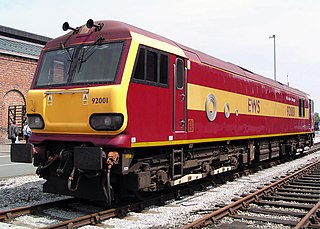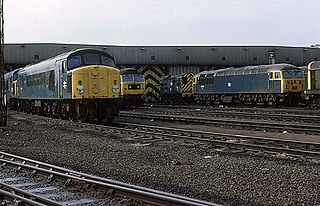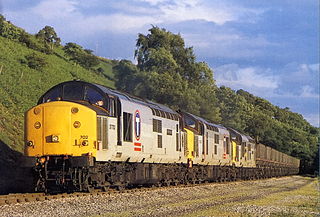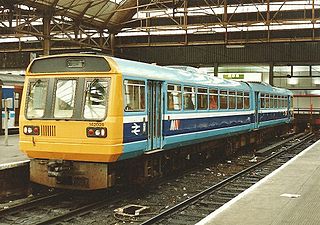
The British Rail Class 09 is a class of 0-6-0 diesel locomotive designed primarily for shunting and also short-distance freight trips along branch lines.

DB Cargo UK, is a British rail freight company headquartered in Doncaster, England.

Freightliner Group is a rail freight and logistics company, formed in the United Kingdom in 1995, and now having expanded into Australia, The Netherlands and Poland. Freightliner Limited is the largest intermodal freight transport operator in the United Kingdom and the second largest freight operating company in the country by revenue, behind DB Cargo UK. It is a subsidiary of Genesee & Wyoming.

The British Rail Class 57 is a type of diesel locomotive that was remanufactured from Class 47s by Brush Traction of Loughborough between 1998 and 2004. The locomotives were fitted with re-conditioned EMD engines and the same model of traction alternator as that fitted to the Class 56.

The Class 66 is a type of six-axle diesel-electric freight locomotive developed in part from the Class 59, for use on the railways of the UK. Since its introduction the class has been successful and has been sold to British and other European railway companies. In Continental Europe it is marketed as the EMD Class 66 (JT42CWR).

British Rail was the brand image of the nationalised railway owner and operator in Great Britain, the British Railways Board, used from 1965 until its breakup and sell-off from 1993 onwards.

Loadhaul Ltd. was a railfreight operator based in the north-east of the United Kingdom. It was formed in 1994, as part of the privatisation of British Rail, and acquired in 1996 by a consortium headed by Wisconsin Central, then merged into a new company English Welsh & Scottish Railway. It is now part of DB Cargo.

The British Rail Class 92 is a dual-voltage electric locomotive, which can run on 25 kV AC from overhead wires or 750 V DC from a third rail. It was designed specifically to operate services through the Channel Tunnel between Great Britain and France. Eurotunnel indicates the Class 92 locomotive as the reference for other locomotives which railway undertakings might want to get certified for usage in the Channel tunnel.
Trainload Freight was the sector of British Rail responsible for trainload freight services. The division was subdivided into four sub-sectors; coal, petroleum, metals and construction.

The British Rail Class 90 electric locomotives were built for mixed-traffic duties, operating from 25 kV AC overhead lines and produce 5,000 bhp (3,700 kW). They weigh 84.5 tonnes and can typically achieve a top speed of 110 mph (177 km/h).

The British Rail (BR) Class 20, otherwise known as an English Electric Type 1, is a class of diesel-electric locomotive. In total, 228 locomotives in the class were built by English Electric between 1957 and 1968, the large number being in part because of the failure of other early designs in the same power range to provide reliable locomotives.

Toton Traction Maintenance Depot or Toton Sidings is one of the largest rail depots in the United Kingdom. Toton TMD is bordered by Long Eaton and Sandiacre in Derbyshire and Toton in Nottinghamshire. The official depot code for Toton TMD is TO, previously shed code 18A. The disused section of Toton sidings is the proposed site for the East Midlands Hub station, on the Leeds branch of High Speed 2, Phase Two.

Tinsley Motive Power Depot, latterly Tinsley Traction Maintenance Depot (TMD), was a railway depot in Tinsley, South Yorkshire, near Sheffield. Access by road was from Brinsworth, near Rotherham. The depot was situated on the freight line between Treeton Junction and the A631 Shepcote Lane.

Dollands Moor Freight Yard is a railway freight yard near Folkestone in Kent, and was purpose built in 1988 for the Channel Tunnel. It is to the west of the Eurotunnel Folkestone Terminal, and just to the south of the M20 Motorway.

Railfreight was a sector of British Rail responsible for all freight operations on the British network. The division was created in 1982 when BR sought to assign particular stock and management to the evolving requirements of freight traffic.
Speedlink was a wagonload freight service operated by British Rail from 1977 to 1991 using air-braked wagons.
In rail freight transportation the terms wagonload or wagonload freight refer to trains made of single wagon consignments of freight. In the US and Canada the term carload refers to a single car of any kind, and manifest train refers to trains made of diverse cars of freight.

The railway network in Great Britain has been used to transport goods of various types and in varying volumes since the early 19th century. Network Rail, which owns and maintains the network, aims to increase the amount of goods carried by rail. In 2015–16 Britain's railways moved 17.8 billion net tonne kilometres, a 20% fall compared to 2014–15. Coal accounted for 13.1% of goods transport in Britain, down considerably from previous years. There are no goods transported by railway in Northern Ireland.

Network NorthWest was a brand name of British Rail which was applied for a short period to the provincial railway network in North West England. It was launched in 1989 during British Rail's sectorisation programme which created distinct brand identities for regional sub-divisions.

Intermodal railfreight in Great Britain is a way of transporting containers between ports, inland ports and terminals in England, Scotland and Wales, by using rail to do so. Initially started by British Rail in the 1960s, the use of containers that could be swapped between different modes of transport goes back to the days of the London, Midland & Scottish Railway.


















